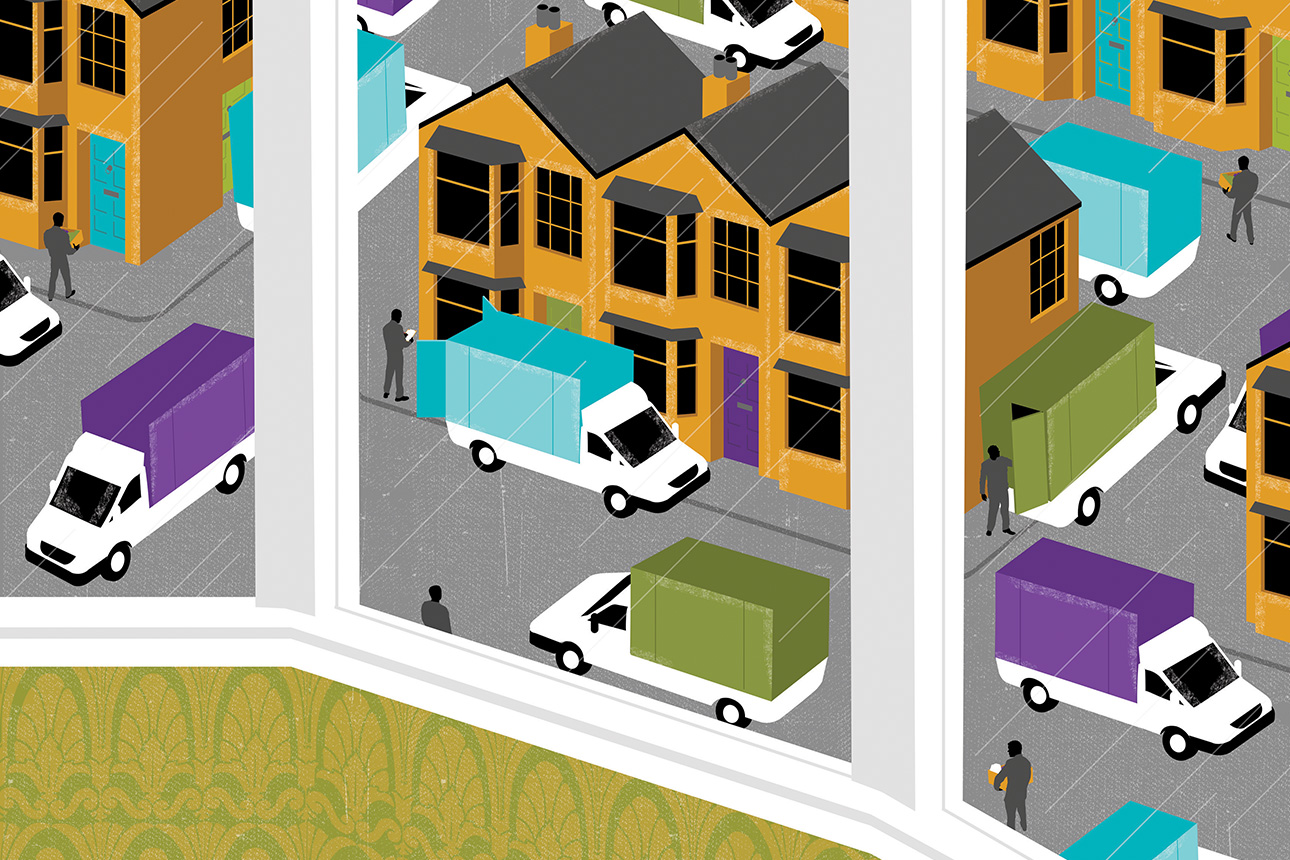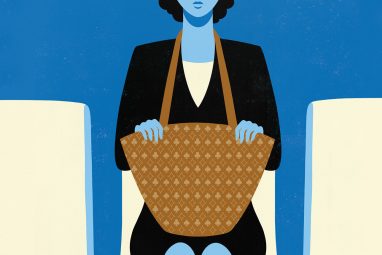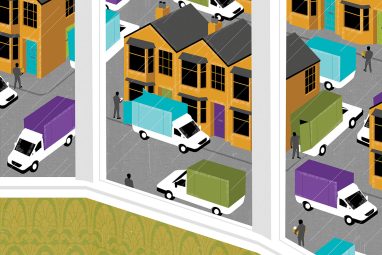Cutting Last-Mile Delivery Costs
New tactics can boost profitability and satisfaction with subscription services.
News
- CERN and Pure Storage Partner to Power Data Innovation in High-Energy Physics
- CyberArk Launches New Machine Identity Security Platform to Protect Cloud Workloads
- Why Cloud Security Is Breaking — And How Leaders Can Fix It
- IBM z17 Mainframe to Power AI Adoption at Scale
- Global GenAI Spending to Hit $644 Billion by 2025, Gartner Projects
- e& enterprise Partners with MIT Sloan Management Review Middle East for GovTech Conclave 2025

Neil Webb/theispot.com
Costco and Amazon subscription services were just the beginning. Consumers can now subscribe to a pickle-of-the-month club, monthly shipments of coloring books, bimonthly boxes of survival tools, and more. Traditional subscription services, such as newspaper or milk deliveries to people’s homes, have been around for decades. But subscription-based home delivery services have become increasingly ubiquitous for other categories of physical products as well.
Subscriptions offer considerable benefits for companies, predictable cash flow chief among them. But for those that deliver physical goods to customers’ doors, the biggest challenge is last-mile delivery costs that eat away at profits. While subscription-based businesses aren’t the only ones that deal with last-mile costs, they are uniquely vulnerable to these costs and in the best position to reduce them.
Last-mile expenses can account for up to 53% of total supply chain costs, as failed deliveries and higher fuel, vehicle, and labor costs strain the system. Another reason expenses are so high is because it’s difficult to optimize logistics for small orders that must be delivered to many different locations, often within a short window of time. Reducing these costs could make the subscription model much more profitable, but most companies haven’t found effective ways to lower them — even though the recurring nature of subscriptions makes this easier than it is under other business models.
I’m a researcher who studies logistics and supply chain management and has worked with companies in South America, Southeast Asia, Europe, and the U.S. to cut operational expenses using cost-effective strategies such as improved delivery routing and scheduling. Based on my research and experience, I believe that a more effective solution exists. But first, let’s take a closer look at the problem and the strategies companies are using today.
Encourage (or Require) Bigger Orders
Unlike Costco’s uniquely successful annual subscription for access to its warehouse stores, most subscriptions for physical products today rely on home delivery rather than consumers visiting brick-and-mortar locations and transporting goods home themselves.
Some subscriptions focus on sending specialty items to consumers at regular intervals — coffee- or wine-of-the-month clubs, for example — which offers companies some predictability and allows them to plan ahead. Others focus on delivery services, where consumers pay an annual fee for discounted or free delivery along with other perks. Such membership programs include Amazon Prime, DoorDash’s DashPass, Grubhub+, and Walmart+.
Many companies require consumers, including subscribers, to meet minimum order values (MOVs), which improves their margins on delivery. Walmart+, for example, offers free grocery delivery for subscribers if they spend more than $35 in a single transaction. But some delivery subscriptions, like Amazon Prime, either avoid setting an MOV or set it low because the company worries that a higher threshold would undercut consumers’ perception of the subscription’s value.
My team worked with a European grocery store and determined that an MOV of approximately 47 euros would be optimal to ensure that all memberships were profitable. Companies shouldn’t be afraid to set high MOVs or experiment with other, less-restrictive methods to incentivize consumers to submit larger orders. For example, a company could provide extra discounts as order size increases, passing on the savings of delivering in bulk to consumers.
Schedule Deliveries and Pool Them by Location
Geographic pooling, which refers to making deliveries at around the same time to a group of consumers who live near one another, is one of the most effective ways to reduce last-mile expenses. If only one person in a neighborhood is subscribed to a meal-kit delivery service, the service must cover the full cost of delivery with the revenue of a single order. But if four other people in the same area also subscribe to the same service, the last-mile costs are split five ways.
Companies can encourage neighbors to align their orders by offering delivery windows or fixed delivery days for an area, rather than promising to deliver as soon as possible. This batching reduces delivery costs by increasing the chance of overlapping orders.
Too many companies try to optimize orders as they come in rather than using incentives to influence when orders come in. They prioritize instantaneous delivery because they think consumers want it. But subscribers also want lower fees — and sometimes they are willing to wait to get them. Surveys and other research have found that many consumers would prefer to wait longer for their order if it means paying less for delivery.
The subscription grocery services Misfit Markets and Imperfect Foods batch orders by ZIP code and deliver only once a week. More companies should explore these models, especially for recurring items that consumers know in advance they’ll need, such as toilet paper or dish soap.
Recurring deliveries cut costs dramatically for retailers. In an ongoing study with a regional grocery chain, my colleagues and I used scheduled delivery dates, consolidation, and split shipments to optimize how goods moved from vendors to distribution centers, reducing transportation costs by approximately 43%. Subscriptions that involve recurring deliveries are especially ripe for this sort of system, offering immense savings.
Companies should pass on these savings and make consumers aware that they’re being rewarded for accepting more sporadic deliveries made on the company’s schedule. Amazon Prime, for example, often offers customers a small digital credit if they opt for slower delivery. Companies can also appeal to eco-conscious customers by highlighting the carbon emissions avoided by scheduling their delivery for a day when a cargo van will already be in their area. Companies that offer a subscription model often incentivize customers to get their friends to sign up by offering a referral credit or discount. They may want to encourage subscribers to get their neighbors to sign up too, offering discounts for joint orders.
Geographic pooling could be built into platforms as well. Imagine if, when a person ordered a pizza via the Uber Eats app, subscribers to its Uber One discount program in the area were notified of a special deal if they ordered from the same restaurant within a certain time frame. Such an approach would offer immediate savings for consumers, more orders for restaurants, potentially more tips and higher productivity for delivery drivers, and lower costs for the delivery app companies themselves.
A New, Combined Approach
Some companies have reduced last-mile delivery costs by implementing MOVs, geographic pooling, and advance scheduling (a form of time-based pooling) — and may still find ways to use these individual strategies to further reduce costs. But what if these principles could be combined into a new kind of subscription model?
My colleague David Pyke and I recently conceptualized a next-generation subscription model we call market basket automatic replenishment, or MBAR. This system would use data analysis and internet-of-things (IoT) monitoring to provide recurring deliveries of commonly used products, batched and customized by neighborhood.
For example, data on neighborhood shopping habits could be used to identify the highest-profit, most-used items within a certain ZIP code. IoT monitoring involves smart devices that know when something is running low — the printer that realizes when it needs more toner or the smart fridge that can tell you what groceries you might need to reorder. Alternatively, machine learning algorithms can learn a customer’s usage patterns over time, predict when the customer is running low on a certain item, and nudge them to reorder.
By combining population-level data on neighborhood trends and individual data from consumers, a retailer could offer the products consumers need most and batch them in recurring intervals to a specific area. The system would know which subscribers in a neighborhood were running low on dish soap or flour and send those items to all of them at once, as part of larger delivery bundles. An alert would go out in advance telling subscribers what they would be receiving that week and allowing them to opt out of anything they didn’t want.
Our research suggests that combining a limited variety of products with order batching substantially decreases the cost of picking, packing, and shipping compared with typical automatic replenishment. Amazon will offer a lower price if you sign up for recurring shipments of a single item, such as toothpaste. But the savings for companies increase drastically when the recurring shipments are for multiple items sent to multiple people in a neighborhood at the same time.
MBAR offers an experimental path to blending convenience and scale. Under the model, customers get what they need, when they need it, without having to ask. Companies get consistent revenue from regular subscribers while drastically cutting last-mile delivery costs. There are also efficiency and environmental benefits to this model, compared with delivering paper towels 10 different times to 10 different households on the same block.
No company has implemented this system yet, though the technology and data to do so are available. Grove offers subscriptions for recurring deliveries of household essentials, but they are still delivered on an individual-customer basis rather than batched by neighborhood. Similarly, Amazon’s now discontinued Dash Smart Shelf automatically ordered a product when its weight dropped below a certain level in a customer’s pantry, but it was always about using individual rather than neighborhood data. Imperfect Foods and Misfits Market offer subscriptions that are geographically clustered, but they deliver only groceries as opposed to a broader set of items.
Whether they try out something like MBAR or pursue another approach, companies that offer subscription services for physical goods must experiment with new kinds of models to reduce last-mile delivery costs. Algorithms can help us optimize delivery schedules. But if neither consumer behavior nor the structure of the delivery system changes, we’ll continue to see companies struggle with last-mile costs and pass them on to frustrated consumers.
The key will be to deliver larger orders to subscribers who live close together, with ample lead time to allow for optimal batching across time and space. These are the elements that will make up the next generation of smart, efficient subscription systems.





